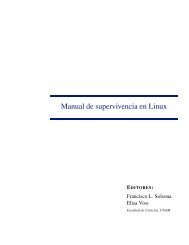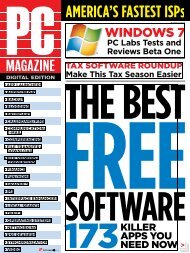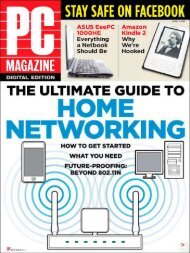PC Magazine - 2009 11.pdf - Libertad Zero
PC Magazine - 2009 11.pdf - Libertad Zero
PC Magazine - 2009 11.pdf - Libertad Zero
Create successful ePaper yourself
Turn your PDF publications into a flip-book with our unique Google optimized e-Paper software.
competition in the likelihood of being recommended,with an SBA of 9.0—a numberworthy to stand with Apple’s. The next bestbrand is Toshiba at an average 8.1.Last year’s second Readers’ Choice,Lenovo, didn’t make the cut this year. Itsscore was down only slightly, but Lenovoalso fell two confidence levels, going froman SBA of 8.1 in 2008 to a 7.9 this year, ascore strictly within the average range.Lenovo did score better than average intech support and repairs, both among alllaptops and with business laptops, where itwas second only to Apple.There was little dramatic movement inscores for any of the other major players.Sony did increase its overall score to 8.1, butthat’s within the average range comparedwith all notebooks, whereas last year itearned a BA 8.0.As we’ve seen before, Dell and Toshibacontinue to get good scores in the likelihoodof being recommended category,higher than each company’s overall scores,in fact; we attribute this to the strength ofthese brand names.At the bottom of the pack this year is HP,with scores that run in tandem with Acerand Gateway. But HP’s 7.7 out of 10 is consideredsignificantly worse than average(SWA), whereas last year it was within in theaverage. For more information on how wemeasure these scores, see below.Taking a closer look at the percentageneeding repairs reveals changes for almostevery vendor; only Acer held steady at 12percent. Apple worsened slightly in this category,along with HP, but the biggest jumpswere for Lenovo, which dropped from 18percent to 22 percent, and Dell, which fellfrom 20 percent to 23 percent (earning it thedubious distinction of highest failure rate ofnotebooks). Sony, Gateway, and Toshibaall had major improvements here, however,Sony from 18 percent last year and Gatewaywith 20 percent last year, both downto 12 percent; Toshiba’s failure rates werereported as 13 percent, down from 19 lastyear. Such significant drops are all well andgood, but none of these companies couldeven touch new entry Asus: Just 6 percentof its products needed repair.METHODOLOGy We e-mailed invitations to <strong>PC</strong> <strong>Magazine</strong> readers to take our online survey, hosted by EquationResearch. Respondents told us about the technology they personally use at home and at work, and any supportor repair incidents they had within the 12 months prior. Respondents were entered into a drawing to win AmericanExpress Gift Checks or prizes provided by ThinkGeek. The survey was in the field in two parts during thesummer months.We score only those vendors represented by at least 50 responses about their products; fewer would notallow for statistically valid comparisons. We use a t-test measure on each score on each question against theaverage of all the scores and determine whether they are significantly different at a 95 percent confidence level.The t-test considers a company’s score for each measure, the total number of responses for the company oneach measure, and the variability of the responses in calculating the confidence interval for each score—therange in which we are 95 percent certain that the score is representative. If the score is more than one confidenceinterval above or below the average, we state that the score is better than or worse than this average. Formore than two confidence intervals above or below, we say that the score is significantly better or worse.56 <strong>PC</strong> MAGAZINE DIGITAL EDITION NOVEMBER <strong>2009</strong>







